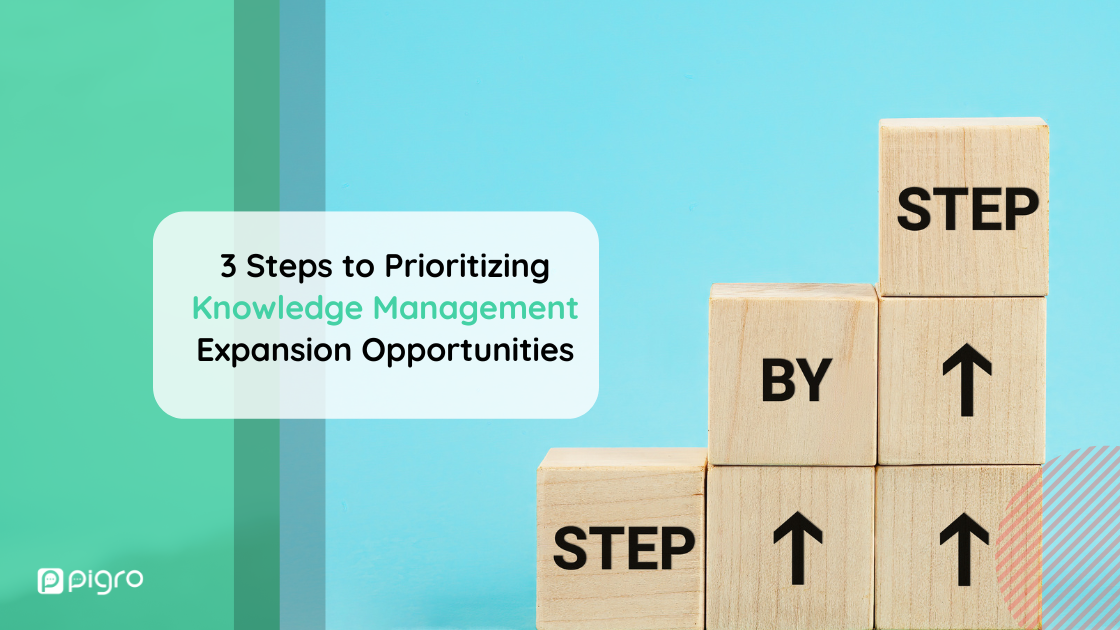Introduction
In the ever-evolving landscape of modern enterprises, the effective management of knowledge stands as a critical pillar for sustainable growth and innovation.
However, amidst the abundance of data and information, organizations often find themselves grappling with the challenge of prioritizing their knowledge management expansion endeavors.
To navigate this complex terrain with precision and efficacy, a strategic approach is imperative. Without a well-defined strategy, organizations may find themselves lost in the vast sea of information, unable to make informed decisions or effectively utilize their knowledge resources. A strategic approach provides a roadmap for success, guiding organizations towards the most valuable expansion opportunities and ensuring optimal utilization of resources.
In today's rapidly evolving business landscape, the importance of a strategic approach to knowledge management cannot be overstated. With the abundance of data and information available, organizations need to prioritize their efforts and focus on the areas that will yield the greatest return on investment.
This requires a thorough understanding of the organization's goals and objectives, as well as a clear vision of how knowledge management aligns with those goals.
A strategic approach also helps organizations navigate the ever-changing technological landscape. With advancements in artificial intelligence, machine learning, and analytics, organizations have access to powerful tools that can unlock valuable insights from their knowledge repositories. However, without a strategic approach, these tools can become overwhelming and ineffective. By strategically prioritizing expansion opportunities, organizations can ensure that they are investing in the right technologies and leveraging them to their fullest potential.
In this article, we delve into three fundamental steps to prioritize knowledge management expansion opportunities, ensuring optimal utilization of resources and maximizing organizational potential.
Step 1: Assessing Knowledge Management Strategy
At the foundation of any successful knowledge management initiative lies a robust strategy tailored to the specific needs and objectives of the organization. The initial step in prioritizing expansion opportunities entails a comprehensive assessment of the existing knowledge management strategy. This evaluation should encompass various dimensions, including the alignment of knowledge management goals with overarching business objectives, the effectiveness of current methodologies and technologies deployed, and the identification of key performance indicators (KPIs) for measuring success.
In conducting this assessment, organizations must leverage sophisticated analytics tools and methodologies to gain actionable insights into their knowledge management ecosystem. This involves analyzing data pertaining to knowledge utilization, user engagement, content relevance, and information accessibility. By harnessing the power of advanced analytics and artificial intelligence (AI), organizations can uncover hidden patterns, trends, and correlations within their knowledge repositories, enabling informed decision-making and strategic planning.
Furthermore, it is essential to evaluate the organization's capacity for knowledge creation, capture, dissemination, and utilization across various departments and functions. This entails assessing the availability of resources, expertise, and infrastructure dedicated to knowledge management activities. By conducting a thorough audit of internal capabilities and processes, organizations can identify areas of strength and weakness, thereby informing the prioritization of expansion opportunities.
Ultimately, the goal of this assessment is to gain a holistic understanding of the organization's knowledge management landscape, identifying areas for improvement and innovation. By leveraging data-driven insights and advanced analytics, organizations can optimize their knowledge management strategy to drive tangible business outcomes, such as productivity improvement, decision-making enhancement, and competitive advantage.
Step 2: Identifying Knowledge Gaps and Opportunities
With a clear understanding of the organization's knowledge management strategy in place, the next step involves identifying knowledge gaps and opportunities for expansion. This entails conducting a comprehensive gap analysis to pinpoint areas where existing knowledge management initiatives fall short in meeting organizational needs and objectives. Key considerations in this process include content relevancy, accessibility, accuracy, and timeliness.
One of the primary challenges organizations face in managing knowledge effectively is the prevalence of tacit knowledge, which resides within the minds of individuals and is often difficult to codify and disseminate. To address this challenge, organizations must adopt innovative approaches to knowledge capture and sharing, leveraging technologies such as enterprise search, natural language processing (NLP), and machine learning to extract insights from unstructured data sources.
Additionally, organizations must focus on knowledge curation, ensuring that relevant and valuable information is surfaced and made readily accessible to those who need it most. This involves the development of curated knowledge repositories, personalized recommendations, and collaborative knowledge-sharing platforms that empower employees to contribute, discover, and leverage knowledge effectively.
By identifying knowledge gaps and opportunities for expansion, organizations can prioritize initiatives that address critical areas of need and drive tangible value across the enterprise. Whether it involves enhancing content discoverability, improving search capabilities, or fostering a culture of knowledge sharing and collaboration, strategic investments in knowledge management expansion can yield significant returns in terms of productivity improvement, decision-making enhancement, and competitive advantage.
Step 3: Prioritizing Expansion Opportunities
With a comprehensive understanding of the organization's knowledge management strategy and identification of key gaps and opportunities, the final step involves prioritizing expansion opportunities based on their strategic importance and potential impact on business outcomes. This requires a systematic approach to decision-making, informed by data-driven insights, stakeholder input, and strategic alignment with overarching business objectives.
In prioritizing expansion opportunities, organizations must consider factors such as the magnitude of the knowledge gap, the feasibility of implementation, the anticipated return on investment (ROI), and the alignment with broader organizational priorities. Additionally, it is essential to assess the risks and challenges associated with each opportunity, as well as the resources and capabilities required for successful execution.
Furthermore, organizations should leverage techniques such as cost-benefit analysis, risk assessment, and scenario planning to evaluate and compare different expansion opportunities objectively. By weighing the potential benefits against the associated costs and risks, organizations can make informed decisions about where to allocate resources and focus their efforts for maximum impact.
Conclusion
Ultimately, the goal of prioritizing expansion opportunities is to ensure that investments in knowledge management yield tangible and sustainable benefits for the organization. Whether it involves investing in technology infrastructure, developing employee training programs, or fostering a culture of knowledge sharing and collaboration, strategic prioritization is essential for driving long-term success and competitiveness in today's knowledge-driven economy. By following these three steps—assessing knowledge management strategy, identifying knowledge gaps and opportunities, and prioritizing expansion opportunities—organizations can chart a course towards enhanced productivity, innovation, and business performance in the digital age.
Read also:
- Can AI Experience Hallucinations? How to Identify False Information Generated by Neural Networks
- How to convert tacit knowledge into explicit knowledge within your company
Want to know more about Pigro? Contact us!



